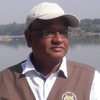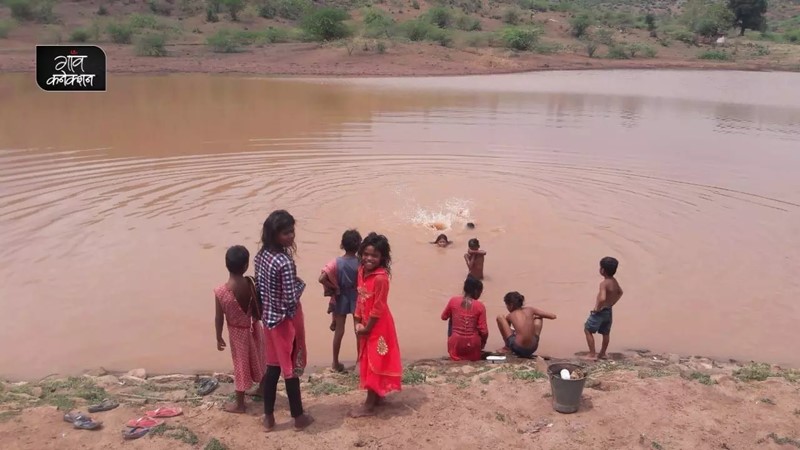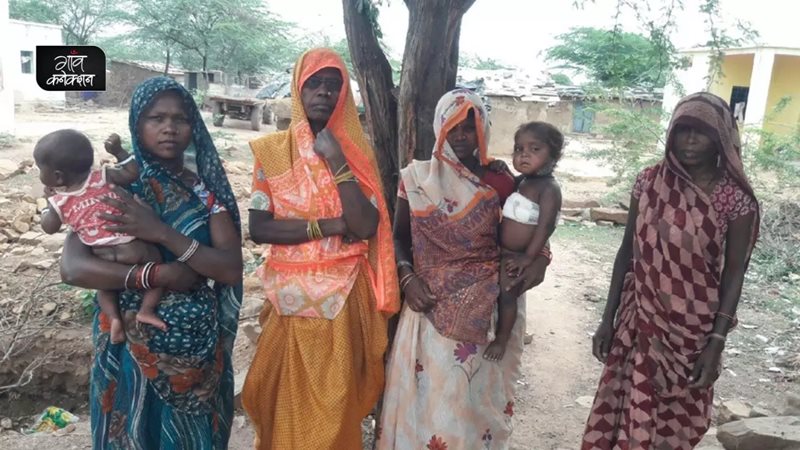High malnutrition and contaminated drinking water afflict tribal population in Panna; three children die in seven days
While three children have lost their lives, 12 more are very sick at Chandmari Basti of Madhya Pradesh, which has a predominantly adivasi population. Contaminated water and malnutrition are being cited as the main reasons for this. An investigation is underway.

Chandmari Basti, Madhya Pradesh
As Karondi Bai made rotis on a griddle in front of her, she also kept a firm hold of her toddler son who was clinging to her. A bandage was wrapped around his torso. “He has a boil. We took him to a private doctor, he is still not too well,” the worried 28-year-old told Gaon Connection.
The young mother is worried because between June 27 and July 2, three children in her neighbourhood have died, and 12 other children in Chandmari Basti, in Panna, Madhya Pradesh, where she lives, are very sick.
One of the children who died was Vineeta, the three-year-old daughter of Rajkali Bai. “It has been ten days since she died. She had cold, cough and a fever. We showed her to Kallu doctor,” the 27-year-old grief-stricken mother, told Gaon Connection.
Vineeta died on June 27. On July 2, four-year-old Shiva and three-year-old Rashim, also died.
Also Read: ‘It is poison, not water, that comes out of the handpumps’
“The water from the talaiyya (small pond), is responsible for it. We use that water for drinking along with the water from the well in the cemetery,” Rajkali Bai said. “The children are the worst affected,” she added.

The murky waters of Chandmari Basti
Chandmari Basti in Panna district, Madhya Pradesh is located about 200 kilometres away from the state capital, Bhopal. It is home to about 50 families, most of them Gaud adivasis.
The approach to Chandmari Basti is difficult. There are no roads and the kachcha pathway is overgrown with scrub. Even a light rain renders the place slushy, making it difficult for vehicles and people to walk through.
There are three main sources of water in the basti (hamlet) — one old and slow hand pump; a community well in the midst of a cemetery about 500 metres away from the basti; and a small pond. The 250 or so inhabitants of Chandmari Basti bathe, wash clothes and use the water from these water sources every day.
Whereas three children have died in a week, 12 children from Chandmari are sick. Two of them are admitted to the Nutrition Rehabilitation Centre (NRC) at the Panna district hospital.
With the death of three children in quick succession, and the media attention that received, there has been a hue and cry about the quality of the water and the cases of malnutrition at Chandmari Basti that falls in the Purushottampur gram panchayat.

Enquiry into the deaths of three children
“Three children have died in Chandmari in Panna district and the enquiry for that is underway,” RS Pandey, chief medical and health officer of Panna, told Gaon Connection.
“They had shown symptoms of cold, cough and fever and we are awaiting the reports to determine the cause of their death,” he added. Other children in the Basti and their families were tested for COVID19, but they have all tested negative, Pandey said.
Also Read: Severely malnourished under-5 children consumed by hunger in the pandemic
“Four-year-old Shiva was malnourished and he was also treated at the NRC. The child also had TB [tuberculosis],” Udal Singh, Panna district programme officer, women and child development department, told Gaon Connection.
Two more children from Chandmari Basti have been found to be malnourished and they are admitted at the NRC, Singh said. “Health workers from the district hospital have visited the other unwell children and given them medicines. They are better now,” he claimed.
Many children in Chandmari Basti are malnourished and deficient in vitamin A, Singh said.
Human Rights Commission demands explanation
On July 6, the State Human Rights Commission, Madhya Pradesh wrote to the principal secretary, health secretary, collector, the secretary of the women and child development department and other health departments in the district asking for an explanation about the deaths, within three weeks.
The public health engineering department declared that the water sources of Chandmari Basti were not contaminated. According to the reports of a public health engineer in Panna, that were sent to the district magistrate and other authorities on July 7, the waters from the well and the handpump were tested and found to be potable. Chlorination of the water was also carried out. The report stated that the media allegations about the water being polluted were false.
Official reports say the children died of cold, cough and fever and that the matter was under investigation. But those cannot possibly be the reason for children losing their lives, protested Sachin Kumar Jain, writer and social worker with the Bhopal-based non profit Vikas Samvad. The organisation raises public health concerns in India, and works on child-centric issues.
“It is imperative to find out the real reason behind the deaths of the children. Cold, cough and fever may be the symptoms, but not the cause of death. Contaminated water and malnutrition are more likely to be the cause,” Jain reiterated.
Also Read: What is the cost of childhood wasting and severe acute malnutrition in India?

High malnourishment
According to the National Family Health Survey (NFHS-4) 2015-16, Madhya Pradesh’s infant mortality rate (IMR) is 51. Under-5 mortality rate is 65.
Further, 42 per cent children below five years of age are stunted (height-for-age), and 42.8 per cent are underweight. Another 25.8 per cent under-5 kids are wasted (weight-for-height).
The situation is worse in Panna, where, according to NFHS-4 , 43.1 per cent of children below five years of age are stunted, 43.3 per cent are underweight and 24.7 per cent are wasted. The same survey also revealed that 69 per cent of children between 6 months and 59 months were found to be anaemic in Panna (rural).
Meanwhile, the inhabitants of Chandmari claim they are forced to drink contaminated water from the handpump or the well. They have no other access to clean water. Karondi Bai and many others have no doubt that it is the contaminated water that is causing the deaths and illness of children in their basti. “We have no running water and round the year we get water from the well,” she said.
Also Read: In election-bound West Bengal, less than 7% rural households have tap water connection

Struggling to earn a living
Most of the inhabitants of Chandmari, both men and women, are daily wagers at the stone quarries or diamond mines nearby. There is no agricultural activity nearby.
“My husband operates a tractor in the mine area. I am a daily wage labourer. If we do not work we can’t eat,” Karondi Bai said. “We had to borrow money to take our child to the doctor,” she added.
“It has been forty years, and we are yet to see any development,” Shyama Bai, a 55-year-old living in Chandmari told Gaon Connection. “We still have to use the water from the dirty sources. We bathe, clean and drink the same water,” she added.
Despite the claims of the government, the people refuse to believe the water is safe to drink. “In order to fill one container of twenty litres of water takes an hour at the handpump,” complained 60-year-old Kripal. “Therefore most people head to the well at the cemetery to fetch water,” he added.

According to Gyanendra Tiwari, programme officer at a non profit Samarthan, that works with adivasis in Panna, Chattarpur and other districts, back in 2014-15 several organisations that work on water and malnutrition had apprised the authorities on ways to address malnutrition. “But nothing has happened so far. The people are still forced to use water from the polluted source,” Tiwari told Gaon Connection.
Also Read: 8.4 million rural households got tap water supply in 22 months: Jal Shakti Ministry
The food security plan of the government had assured the marginalised communities that they would benefit from it. But, many inhabitants of Chandmari Basti, remain outside the loop. “I have neither ration card, nor do I receive any rations as promised by the food security programme,” Rajkali, an adivasi from the basti, told Gaon Connection. Children are also not regularly receiving the promised nutritious food at anganwadis, she said.
“Even the gram panchayat is giving the inhabitants of Chandmari the step-treatment,” Sameena Yusuf, director Prithvi Trust, Panna told Gaon Connection. “When Chandmari Basti was detached from Panna Municipal Corporation, and became a part of the rural Purushottam gram panchayat, people here ceased to receive any rations, pensions, etc.,” Yusuf pointed out. “Most of the funds are being used to develop Badi Bakhri village in the panchayat,” she alleged.
Meanwhile, as the Jal Jeevan Mission, under the Ministry of Jal Shakti aspires to provide safe and piped drinking water to every rural household by 2024, the inhabitants of Chandmari Basti, continue to use the contaminated water for their daily use, with a prayer on their lips that it will not kill their children.
Read the story in Hindi.

